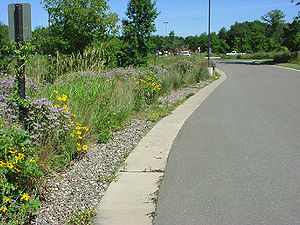
Stormwater infiltration practices capture and temporarily store stormwater before allowing it to infiltrate into the soil. Design variants include; the infiltration basin, the infiltration trench, the dry well and the underground infiltration system. As the stormwater penetrates the underlying soil, chemical, biological and physical processes remove pollutants and delay peak stormwater flows.
Infiltration practices are applicable to sites with naturally permeable soils and a suitable distance to the seasonally high groundwater table, bedrock or other impermeable layer. They may be used in residential and other urban settings where elevated runoff volumes, pollutant loads, and runoff temperatures are a concern. In applications where the stormwater runoff has a particularly high pollutant load or where the soils have very high Infiltration rates, a significant amount of pre-treatment should be provided to protect the groundwater quality. Sources that include potential stormwater hotsposts (PSH) should not be introduced to Infiltration areas.
Infiltration trench articles
- Overview for Infiltration trench
- Types of Infiltration trench
- Design criteria for Infiltration trench
- Construction specifications for Infiltration trench
- Operation and maintenance of Infiltration trench
- Assessing the performance of infiltration
- Calculating credits for infiltration trench
- Cost-benefit considerations for Infiltration trench
- External resources for Infiltration trench
- References for infiltration
- Requirements, recommendations and information for using infiltration basin/underground infiltration BMPs in the MIDS calculator
Related pages
This page was last edited on 12 January 2023, at 16:25.
